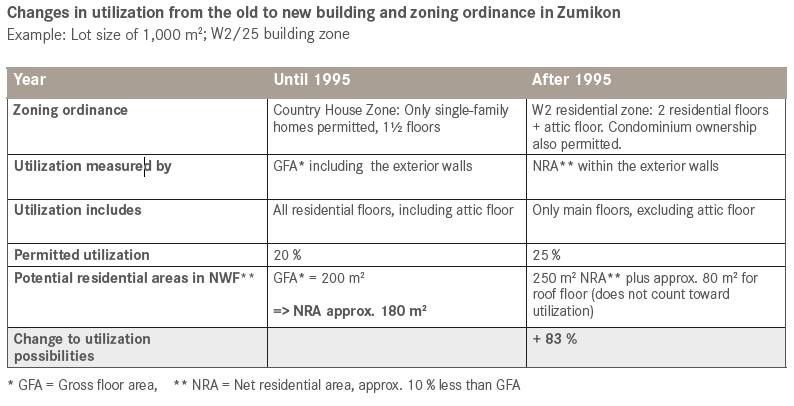Evolution of land use planning
The voters of the Canton of Zurich approved the Revised Development and Zoning Plan in 1995. Through this revision, single family housing zones were eliminated in the entire Canton. The much higher land utilization today means an ever greater number of single-family homes are being torn down and replaced with multifamily residences. This would have been totally inconceivable in certain select (country home) zones in the past. Various municipalities have changed their calculation method from residential floor space to cubic capacity, which increased land utilization.
Real estate prices have downright exploded over the last five years on both banks of Lake Zurich. There is hardly any supply, while demand is enormous. Has land use planning failed?
On the current situation: Urban density versus ownership rights
Voiced from the left wing and the greens are getting louder demanding even greater urban density (also known as conurbation). The same exponents oppose urban sprawl, i.e., the creation of new residential areas in current reserve zones. A few interest groups even demand that new rezoning for pure single-family housing districts be completely excluded. Also, architectural models would have to be developed for conurbation of interior building land reserves - i.e., existing single-family housing districts. In fiscal terms, these guardians of the landscape demand that underdeveloped parcels in the middle of developed areas should bear the tax burden. They even seek the acquisition of conurbation parcels through the public sector.
Incidentally, the developed area in all of Switzerland comprises just under 7 %; by contrast, agricultural lands cover 37 %. Yet by 1996, roughly 20.1 % of the area in the Canton of Zurich was already fully improved as developed area.
Municipalities around Lake Zurich with a liberal persuasion have entirely different goals: They want to safeguard private residential ownership. The town of Zollikon got to the heart of the matter in its 2005 Preliminary Zoning Plan: According to the current building and zoning ordinance, Zollikon is overbuilt by just 2/3; thus, each parcel still has the potential to deliver 1/3 more cubic capacity on average. Nevertheless, the building boom would lead to problems: „In several districts, the comprehensive, total consumption of the permitted utilization would lead to a bleak and undesirable urban landscape.“ Unfortunately, the Municipal Assembly did not accept the Preliminary Zoning Plan with its proposed reduced utilization (down-zoning), unlike the town of Küsnacht, which approved one for a few areas of the town in 2004. The race has long since begun in Zollikon as well as in other communities: Ever higher, ever wider! The implications for land owners are fatal, everyone is obstructing each other‘s view; neighbors are moving closer and closer, and privacy is the cost.
One can certainly find properties with the greatest privacy in Zumikon. Here, large residential areas are still in zone W2/25, which is a zone with a very reduced utilization and large setbacks of twice 12 m (by comparison: several towns have only 6 or 7 meter setbacks in residential zones). In Zumikon, the expensive residences and estates are still protected from intrusive neighboring structures. How long that will last is written in the stars. Under conurbation, eventually the question will be raisedin Zumikon whether such a restrictive hold over construction can be upheld in the future. The right wing controlled municipal council will definitely meet this question with all due caution, due to the fact that in this municipality as well, land utilization has increased substantially since 1995 – as demonstrated by the following example.

The bottom line on the current situation
The development of land use planning remains fascinating, and is becoming a political football between liberal and socialist thinking. Conurbation trends are unmistakable - from political parties, from architects (interesting architecture) and from the construction industry (potential contracts).
A decision must be made: For how many inhabitants should a region build, and what land use planning measures are prudent and desired/supported by the citizens? Conurbation through high-rise districts in non-sensitive locations certainly has to be discussed. But the destruction of green, well-maintained residential areas demanded by certain exponents must be scrutinized with a highly critical eye, and may also be denied acceptance among the population.
As immigration rises and/or the standard of living increases, the spatial needs in the Zurich region will become greater. The inevitable question here is whether to develop horizontally (urban sprawl, zoning-in of land reserves) or vertically (density). Both options have their pros and cons, which are weighted differently depending on the observer or the interest. In any case, land planning decisions will have an impact on the further price development in the hot spots of the Lake Zurich communities.
Author: Claude Ginesta

Claude A. Ginesta is a federally licensed real estate fiduciary (registered with the SVIT, the Swiss Federation of Real Estate Fiduciaries) and owner and CEO of Ginesta Real Estate AG. The company was founded in 1944 and specializes in the sale of properties in the Zurich and Grisons markets. With offices in Küsnacht, Horgen and Chur, the company operates as real estate broker throughout Switzerland for properties located across the country.
Publisher of the “Illusions” series: Ginesta Real Estate AG, www.ginesta.ch









